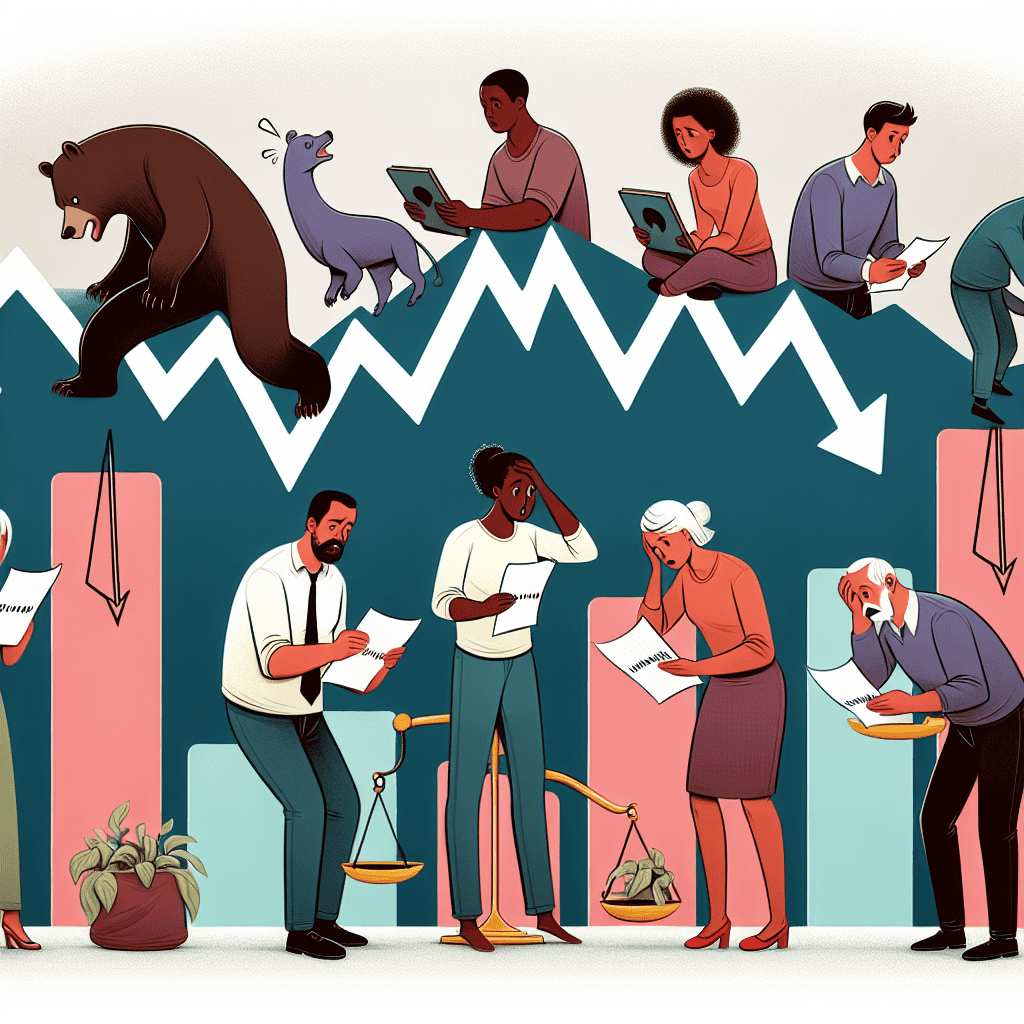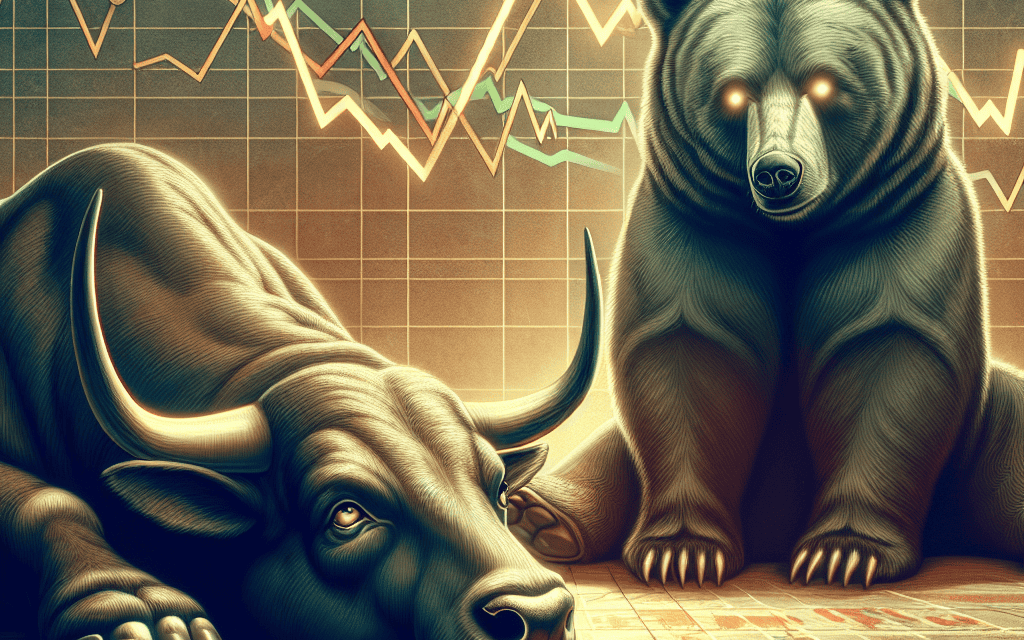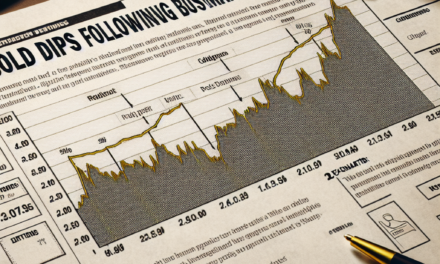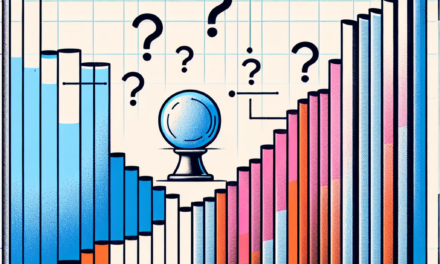“Market Slump: The Calm After the Rally Storm”
Introduction
In recent times, the financial markets have experienced a notable downturn, characterized by a market slump as investor enthusiasm wanes following a period of robust rally. This shift in sentiment marks a significant transition from the buoyant optimism that fueled market gains, driven by factors such as economic recovery hopes, fiscal stimulus, and accommodative monetary policies. However, as these initial drivers begin to lose momentum, investors are increasingly cautious, reassessing valuations and potential risks. Concerns over inflation, interest rate hikes, geopolitical tensions, and uneven economic growth have contributed to this cooling enthusiasm, prompting a reevaluation of investment strategies. The resulting market slump underscores the inherent volatility and cyclical nature of financial markets, highlighting the delicate balance between risk and reward that investors must navigate.
Analyzing the Causes of the Recent Market Slump
The recent market slump has caught the attention of investors and analysts alike, as the enthusiasm that fueled a previous rally seems to have waned. Understanding the causes of this downturn requires a multifaceted analysis, as several factors have converged to create an environment of uncertainty and caution. Initially, the rally was driven by a combination of strong corporate earnings, optimism about economic recovery, and accommodative monetary policies. However, as these factors began to shift, so too did investor sentiment.
One of the primary causes of the market slump is the changing landscape of monetary policy. Central banks around the world, particularly the Federal Reserve, have signaled a shift towards tightening monetary conditions. This shift is largely in response to rising inflationary pressures, which have been exacerbated by supply chain disruptions and increased consumer demand. As a result, the prospect of higher interest rates has led to a reevaluation of asset valuations, particularly in sectors that are sensitive to borrowing costs. Consequently, investors have become more cautious, leading to a pullback in market enthusiasm.
In addition to monetary policy changes, geopolitical tensions have also played a significant role in dampening investor confidence. Ongoing conflicts and diplomatic standoffs have created an atmosphere of uncertainty, which has been further compounded by concerns over global trade relations. These geopolitical risks have prompted investors to reassess their risk exposure, leading to a more defensive posture in their investment strategies. As a result, there has been a noticeable shift away from riskier assets, contributing to the overall market decline.
Moreover, the resurgence of COVID-19 cases in various parts of the world has added another layer of complexity to the market environment. Despite widespread vaccination efforts, new variants of the virus have emerged, raising concerns about the potential for renewed restrictions and their impact on economic activity. This uncertainty has led to increased volatility in the markets, as investors grapple with the potential implications for growth and corporate earnings. The interplay between pandemic-related developments and market dynamics has thus become a critical factor in shaping investor sentiment.
Furthermore, corporate earnings, which had been a key driver of the previous rally, have started to show signs of strain. While many companies have reported strong results, there are growing concerns about the sustainability of these earnings in the face of rising input costs and labor shortages. As companies navigate these challenges, profit margins may come under pressure, leading to downward revisions in earnings forecasts. This has prompted investors to adopt a more cautious approach, as they weigh the potential risks to future profitability.
In conclusion, the recent market slump can be attributed to a confluence of factors, including shifts in monetary policy, geopolitical tensions, pandemic-related uncertainties, and concerns about corporate earnings. As these elements continue to evolve, they will undoubtedly influence investor sentiment and market dynamics. While the path forward remains uncertain, it is clear that a careful analysis of these factors is essential for understanding the current market environment. By staying informed and adapting to changing conditions, investors can better navigate the challenges and opportunities that lie ahead.
Strategies for Investors During a Market Downturn
In the wake of a market slump following a period of enthusiastic rallies, investors are often left grappling with uncertainty and seeking strategies to navigate the downturn effectively. Understanding the dynamics of market cycles is crucial, as it allows investors to make informed decisions rather than reacting impulsively to short-term fluctuations. During a downturn, it is essential to adopt a strategic approach that balances risk management with potential opportunities for growth.
One of the primary strategies during a market downturn is diversification. By spreading investments across various asset classes, sectors, and geographic regions, investors can mitigate the risk associated with any single investment. Diversification helps cushion the impact of a downturn in one area by potentially offsetting losses with gains in another. For instance, while equities may be underperforming, bonds or commodities might offer more stability or even growth, providing a buffer against market volatility.
In addition to diversification, maintaining a long-term perspective is vital. Market downturns, while challenging, are often temporary phases within the broader economic cycle. Investors who remain focused on their long-term goals are better positioned to weather short-term volatility. This approach requires discipline and patience, as it involves resisting the urge to sell off assets in a panic. Instead, investors should consider the downturn as an opportunity to reassess their portfolios and make adjustments that align with their long-term objectives.
Moreover, during a market slump, it is prudent to focus on quality investments. Companies with strong fundamentals, such as solid balance sheets, consistent cash flow, and a competitive edge in their industry, are more likely to withstand economic challenges. By prioritizing quality, investors can reduce the risk of significant losses and position themselves for potential gains when the market recovers. Conducting thorough research and analysis is essential to identify such opportunities, ensuring that investment decisions are based on sound financial principles rather than market speculation.
Another effective strategy is to maintain liquidity. Having access to cash or cash-equivalent assets provides flexibility and the ability to capitalize on opportunities that may arise during a downturn. For instance, market slumps often lead to undervalued stocks, presenting a chance for investors to acquire quality assets at a discount. By maintaining liquidity, investors can take advantage of these opportunities without the need to liquidate other investments at a loss.
Furthermore, it is important to stay informed and adapt to changing market conditions. Regularly reviewing economic indicators, market trends, and geopolitical developments can provide valuable insights into potential risks and opportunities. Staying informed enables investors to make timely adjustments to their strategies, ensuring they remain aligned with the evolving market landscape.
In conclusion, while market downturns can be unsettling, they also present opportunities for strategic investors. By diversifying portfolios, maintaining a long-term perspective, focusing on quality investments, ensuring liquidity, and staying informed, investors can navigate the challenges of a market slump with confidence. These strategies not only help mitigate risks but also position investors to capitalize on potential gains when the market eventually rebounds. As history has shown, markets are cyclical, and those who remain disciplined and strategic are often rewarded in the long run.
The Impact of Waning Investor Enthusiasm on Global Markets
The recent downturn in global markets has been a cause for concern among investors and analysts alike, as the initial enthusiasm that fueled a significant rally appears to be waning. This shift in sentiment has led to a market slump, raising questions about the sustainability of the previous gains and the underlying factors contributing to this change in investor behavior. Understanding the impact of waning investor enthusiasm on global markets requires a closer examination of the dynamics at play, including economic indicators, geopolitical tensions, and shifts in monetary policy.
Initially, the rally was driven by a combination of factors, including robust corporate earnings, optimism about economic recovery post-pandemic, and accommodative monetary policies from central banks around the world. These elements created a favorable environment for investors, who were eager to capitalize on the upward momentum. However, as the rally progressed, several warning signs began to emerge, suggesting that the market’s exuberance might not be sustainable in the long term.
One of the primary factors contributing to the current market slump is the growing concern over inflationary pressures. As economies reopened and demand surged, supply chain disruptions and labor shortages led to increased costs for goods and services. Central banks, which had previously maintained low interest rates to support economic recovery, are now faced with the challenge of balancing growth with inflation control. The prospect of tighter monetary policy, including potential interest rate hikes, has made investors more cautious, leading to a reevaluation of risk and a subsequent pullback from equities.
Moreover, geopolitical tensions have added another layer of uncertainty to the markets. Ongoing conflicts and diplomatic standoffs in various regions have heightened the risk of economic disruptions, further dampening investor confidence. The interconnected nature of global markets means that instability in one area can have ripple effects across the world, exacerbating the challenges faced by investors seeking to navigate an increasingly complex landscape.
In addition to these macroeconomic and geopolitical factors, there is also a growing recognition that some sectors may have become overvalued during the rally. The technology sector, in particular, experienced significant gains as investors flocked to companies that benefited from the accelerated digital transformation during the pandemic. However, as valuations soared, concerns about potential bubbles emerged, prompting a reassessment of investment strategies and a shift towards more defensive positions.
Despite these challenges, it is important to note that market slumps are not uncommon and can serve as a natural part of the economic cycle. They provide an opportunity for investors to recalibrate their portfolios, identify undervalued assets, and position themselves for future growth. While the current environment may be characterized by uncertainty, it also underscores the importance of maintaining a long-term perspective and a diversified investment approach.
In conclusion, the waning investor enthusiasm that has led to the recent market slump is a reflection of the complex interplay between economic indicators, geopolitical tensions, and shifts in monetary policy. As investors navigate this challenging landscape, it is crucial to remain informed and adaptable, recognizing that market fluctuations are an inherent part of the investment journey. By understanding the underlying factors driving these changes, investors can better position themselves to weather the storm and capitalize on opportunities that may arise in the future.
Historical Market Rallies and Subsequent Slumps: Lessons Learned

Throughout history, financial markets have experienced numerous rallies followed by inevitable slumps, offering valuable lessons for investors and analysts alike. These cycles of exuberance and decline are not merely random occurrences but are often driven by a complex interplay of economic indicators, investor sentiment, and external events. Understanding these patterns can provide insights into the current market slump as investor enthusiasm wanes after a recent rally.
To begin with, it is essential to recognize that market rallies are typically fueled by a combination of positive economic data, corporate earnings growth, and investor optimism. For instance, the post-World War II economic boom in the United States was characterized by rapid industrial growth and technological advancements, leading to a prolonged market rally. Similarly, the dot-com boom of the late 1990s was driven by the rapid expansion of internet-based companies, which captured the imagination of investors and led to soaring stock prices.
However, history has shown that such rallies often sow the seeds of their own demise. As markets climb, valuations can become stretched, and the disconnect between stock prices and underlying economic fundamentals grows. This was evident during the dot-com bubble, where many companies with little to no earnings were valued at astronomical levels. Eventually, reality sets in, and the market corrects itself, leading to a slump. The bursting of the dot-com bubble in the early 2000s serves as a stark reminder of the dangers of unchecked investor enthusiasm.
Moreover, external shocks can also play a significant role in precipitating market slumps. The 2008 financial crisis, for example, was triggered by the collapse of the housing market and the subsequent failure of major financial institutions. This crisis highlighted the interconnectedness of global markets and the potential for localized issues to have far-reaching consequences. In this context, the current market slump can be seen as part of a broader pattern where external factors, such as geopolitical tensions or unexpected economic downturns, can quickly dampen investor sentiment.
In addition to these factors, psychological elements also contribute to the cyclical nature of markets. Behavioral finance studies have shown that investors are prone to cognitive biases, such as overconfidence and herd behavior, which can exacerbate market swings. During rallies, investors may become overly optimistic, ignoring warning signs and driving prices higher. Conversely, during slumps, fear and panic can lead to indiscriminate selling, further exacerbating the decline.
As we reflect on these historical patterns, it becomes clear that the current market slump is not an isolated event but rather part of a recurring cycle. While it is challenging to predict the exact timing and magnitude of market movements, understanding the underlying drivers can help investors make more informed decisions. Diversification, risk management, and a focus on long-term fundamentals remain crucial strategies for navigating these turbulent times.
In conclusion, the lessons learned from past market rallies and subsequent slumps underscore the importance of maintaining a balanced perspective. While market cycles are inevitable, they also present opportunities for those who are prepared. By studying historical patterns and remaining vigilant to changing conditions, investors can better position themselves to weather the storms and capitalize on future rallies.
How to Identify Safe Havens in a Volatile Market
In the wake of a market slump following a period of investor enthusiasm, identifying safe havens becomes crucial for those seeking to protect their assets. As volatility rears its head, the challenge lies in discerning which investments can offer stability amidst the turbulence. To navigate this uncertain landscape, investors must employ a strategic approach, focusing on assets traditionally known for their resilience during economic downturns.
Firstly, it is essential to consider government bonds, often regarded as a cornerstone of safe-haven investing. These securities are backed by the full faith and credit of the issuing government, making them a reliable choice when market conditions become unpredictable. U.S. Treasury bonds, in particular, are highly sought after due to their perceived safety and liquidity. During periods of market instability, investors typically flock to these bonds, driving up their prices and providing a buffer against losses in riskier asset classes.
In addition to government bonds, precious metals such as gold have long been considered a refuge in times of financial uncertainty. Gold’s intrinsic value and historical role as a store of wealth make it an attractive option for those looking to hedge against market volatility. Its performance often inversely correlates with the stock market, providing a counterbalance to equity investments. As a tangible asset, gold is not subject to the same risks as paper currencies, which can be devalued through inflationary pressures.
Moreover, investors may turn to defensive stocks, which are shares in companies that produce essential goods and services. These businesses, including those in the utilities, healthcare, and consumer staples sectors, tend to maintain stable earnings regardless of economic conditions. Their products remain in demand even during downturns, offering a degree of protection against market fluctuations. By incorporating defensive stocks into their portfolios, investors can achieve a more balanced risk profile.
Real estate investment trusts (REITs) also present a potential safe haven, particularly those focused on sectors with steady demand, such as residential and healthcare properties. REITs provide exposure to real estate markets without the need for direct property ownership, offering both diversification and income through dividends. While not immune to market volatility, certain REITs can offer stability due to their underlying assets’ consistent demand.
Furthermore, diversification remains a fundamental strategy in mitigating risk during volatile periods. By spreading investments across various asset classes, sectors, and geographic regions, investors can reduce the impact of any single market event on their overall portfolio. This approach not only helps in managing risk but also positions investors to capitalize on opportunities that may arise in different areas of the market.
In conclusion, as investor enthusiasm wanes and market volatility increases, identifying safe havens becomes paramount. By focusing on government bonds, precious metals, defensive stocks, and REITs, investors can build a resilient portfolio capable of weathering economic storms. Additionally, maintaining a diversified investment strategy ensures that risks are spread and potential returns are maximized. As the market landscape continues to evolve, staying informed and adaptable will be key to navigating the challenges and opportunities that lie ahead.
The Role of Economic Indicators in Predicting Market Trends
In the ever-evolving landscape of financial markets, the role of economic indicators in predicting market trends cannot be overstated. These indicators serve as vital tools for investors, analysts, and policymakers alike, providing insights into the health and direction of an economy. As investor enthusiasm wanes following a recent market rally, understanding these indicators becomes even more crucial. Economic indicators, such as GDP growth rates, unemployment figures, and inflation data, offer a snapshot of economic performance and potential future trends. For instance, a robust GDP growth rate often signals a healthy economy, which can boost investor confidence and drive market rallies. Conversely, a slowdown in GDP growth may indicate economic challenges ahead, prompting investors to reassess their positions. In the context of the recent market slump, it is essential to examine how these indicators have influenced investor sentiment.
Unemployment figures are another critical economic indicator that can significantly impact market trends. A low unemployment rate typically suggests a strong labor market, which can lead to increased consumer spending and, consequently, economic growth. However, if unemployment begins to rise, it may signal underlying economic weaknesses, causing investors to become more cautious. In recent months, fluctuations in unemployment data have contributed to the shifting investor sentiment, as concerns about potential economic slowdowns have emerged. Inflation data also plays a pivotal role in shaping market trends. Rising inflation can erode purchasing power and lead to higher interest rates, which can dampen economic growth and weigh on market performance. On the other hand, moderate inflation is often seen as a sign of a growing economy. The recent market slump can be partly attributed to fears of rising inflation, as investors worry about the potential impact on corporate profits and consumer spending.
Moreover, central bank policies, which are often influenced by economic indicators, can have a profound effect on market trends. For example, if a central bank raises interest rates to combat inflation, it can lead to higher borrowing costs and reduced consumer spending, potentially slowing economic growth. Conversely, a decision to lower interest rates can stimulate economic activity by making borrowing more affordable. In the current market environment, investors are closely monitoring central bank actions, as any changes in monetary policy could have significant implications for market performance. In addition to these traditional economic indicators, newer metrics such as consumer sentiment indices and business confidence surveys have gained prominence in recent years. These indicators provide valuable insights into the mindset of consumers and businesses, which can influence spending and investment decisions. A decline in consumer sentiment, for example, may signal reduced consumer spending, which can negatively impact economic growth and market performance.
As the market experiences a slump following a period of rallying, it is crucial for investors to pay close attention to these economic indicators. By analyzing the data and understanding the underlying trends, investors can make more informed decisions and better navigate the complexities of the financial markets. While no single indicator can predict market trends with absolute certainty, a comprehensive analysis of multiple indicators can provide valuable insights into the potential direction of the economy and the markets. In conclusion, economic indicators play a vital role in predicting market trends and guiding investor decisions. As investor enthusiasm wanes after a rally, understanding these indicators becomes even more important. By closely monitoring GDP growth rates, unemployment figures, inflation data, and other key metrics, investors can gain a clearer picture of the economic landscape and make more informed investment choices.
Psychological Factors Influencing Investor Behavior in a Slump
Investor behavior is a complex interplay of various psychological factors, particularly during periods of market volatility. When markets experience a slump following a rally, as is currently observed, understanding these psychological influences becomes crucial. Investors, driven by a mix of emotions and cognitive biases, often react in ways that may not align with rational decision-making. This divergence from rationality can exacerbate market downturns, as fear and uncertainty take hold.
One of the primary psychological factors at play is the concept of loss aversion. This principle suggests that investors feel the pain of losses more acutely than the pleasure of equivalent gains. Consequently, when markets begin to decline after a period of growth, the fear of losing capital can lead to panic selling. This behavior, driven by the desire to avoid further losses, can contribute to a self-fulfilling prophecy, where the market continues to fall as more investors sell off their assets.
In addition to loss aversion, herd behavior significantly influences investor actions during a market slump. Investors often look to the actions of others as a guide, especially in uncertain times. When a significant number of investors begin to sell, others may follow suit, fearing they might miss the opportunity to exit before prices drop further. This collective movement can amplify market declines, as the selling pressure increases and prices continue to fall.
Moreover, the recency effect plays a crucial role in shaping investor expectations and decisions. This cognitive bias leads individuals to give undue weight to recent events when making judgments about the future. After a market rally, investors may become overly optimistic, expecting the upward trend to continue indefinitely. However, when the market begins to slump, the sudden shift can catch investors off guard, leading to heightened anxiety and impulsive decision-making.
Another psychological factor that can influence investor behavior during a slump is overconfidence. During a rally, investors may develop an inflated sense of their ability to predict market movements, leading to riskier investment choices. However, when the market turns, this overconfidence can quickly turn into doubt and fear, prompting hasty decisions to sell off assets in an attempt to mitigate perceived risks.
Furthermore, the role of media and information dissemination cannot be overlooked. In today’s digital age, investors are bombarded with a constant stream of news and analysis. During a market slump, negative news can dominate headlines, further fueling fear and uncertainty. This information overload can lead to analysis paralysis, where investors become overwhelmed and unable to make informed decisions, or it can result in knee-jerk reactions based on sensationalized reports.
To navigate these psychological challenges, investors can benefit from adopting a long-term perspective and maintaining a disciplined approach to investing. Diversification, regular portfolio reviews, and adherence to a well-defined investment strategy can help mitigate the impact of emotional decision-making. Additionally, seeking professional financial advice can provide an objective perspective, helping investors to remain focused on their long-term goals rather than being swayed by short-term market fluctuations.
In conclusion, understanding the psychological factors that influence investor behavior during a market slump is essential for both individual investors and market analysts. By recognizing the impact of loss aversion, herd behavior, cognitive biases, and media influence, investors can better manage their reactions to market volatility. Ultimately, fostering awareness of these psychological dynamics can lead to more informed and rational investment decisions, even in the face of market uncertainty.
Q&A
1. **What is a market slump?**
A market slump refers to a significant decline in stock prices across major indices, often triggered by economic concerns, geopolitical events, or shifts in investor sentiment.
2. **What causes investor enthusiasm to wane after a rally?**
Investor enthusiasm can wane due to factors such as overvaluation concerns, disappointing economic data, geopolitical tensions, or changes in monetary policy that suggest future challenges.
3. **How does a market rally typically end?**
A market rally often ends when investors start taking profits, economic indicators suggest a slowdown, or external events create uncertainty, leading to a shift in market sentiment.
4. **What are the signs of a market slump?**
Signs of a market slump include declining stock prices, increased volatility, reduced trading volumes, and negative investor sentiment reflected in market commentary.
5. **How do investors typically react to a market slump?**
Investors may react to a market slump by selling off stocks to minimize losses, reallocating assets to safer investments like bonds, or holding cash until market conditions stabilize.
6. **What impact does a market slump have on the economy?**
A market slump can lead to reduced consumer and business confidence, lower investment levels, and potential slowdowns in economic growth if prolonged.
7. **What strategies can investors use during a market slump?**
During a market slump, investors might focus on diversification, investing in defensive stocks, maintaining a long-term perspective, or using hedging strategies to protect their portfolios.
Conclusion
The recent market slump, following a period of rally, underscores the volatility and unpredictability inherent in financial markets. As investor enthusiasm wanes, several factors contribute to this downturn, including concerns over economic indicators, geopolitical tensions, and potential shifts in monetary policy. The initial rally may have been driven by optimism and speculative investments, but the subsequent decline highlights the importance of sustainable growth and sound economic fundamentals. This market correction serves as a reminder for investors to remain cautious and diversified in their portfolios, as market sentiment can swiftly change in response to new information and evolving global conditions.





